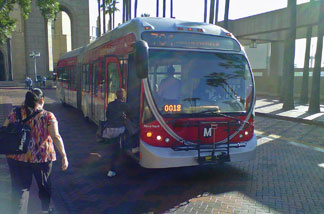Dec 14th, 2011 | Posted by Robert Cruickshank
I have no idea why the LA Times thought it would be a good idea to put Ralph Vartabedian on the high speed rail beat, but the results have been disastrous. The guy has no clue how the project actually works and almost certainly has never actually used a high speed train in his life. The result has been a series of nonsensical articles trashing the project for common-sense things that are not actually newsworthy issues.
Today’s article from Vartabedian is perhaps the worst yet. In it, he actually argues that the requirement that trains connect San Francisco to Los Angeles in 2 hours and 40 minutes was somehow a shocking thing sneaked into the Prop 1A legislation without anybody realizing its intent.
I’m serious. That’s actually the story he filed. Vartabedian basically thinks it’s somehow a major news story that a high speed train is intended to achieve high speeds:
California’s proposed bullet train will need to soar over small towns on towering viaducts, split rich farm fields diagonally and burrow for miles under mountains for a simple reason: It has no time to spare.
In the fine print of a 2008 voter-approved measure funding the project was a little-noticed requirement that trains be able to rocket from Union Station in downtown Los Angeles to San Francisco in no more than two hours and 40 minutes.
It was an aggressive goal, requiring cutting-edge technology, and was originally intended to protect the sanctity of the bullet train concept from political compromise. Whether the California High Speed Rail Authority can meet such a schedule is far from certain. Even some backers of the project now say it was a mistake to lock in the strict requirement.
Huh? It wasn’t “fine print” – HSR supporters like me shouted from the rooftops that the trains would connect SF to LA in just over two and a half hours. It was compelling. It was sensible. It was one of the things that generated public support for the project. We put together postcards that fall with the following image on one side and handed them out at train stations across the state, such as Union Station, loudly trumpeting the travel time:

After all, people understood that they were voting for high speed rail. They were voting for short travel times. That’s the entire point of high speed rail – to be something other than Amtrak, to provide fast and reliable transportation between California’s metro areas.
For Vartabedian to treat this as something of a surprise just shows how disreputable a journalist he really is. That travel time is comparable to other successful HSR routes around the world. Spain’s AVE train connects Madrid and Barcelona in 2 hours, 38 minutes. France’s LGV Est operates trains at speeds of 200 mph. Given technological improvements, 220 mph by 2020 is a reasonable expectation.
Instead Vartabedian makes this sound like some hidden trick, and quotes high speed rail opponent Alan Lowenthal to supposedly make his case:
Some state legislative leaders and rail authority officials say the time requirement never should have been put into the law. “It was a mistake,” said Sen. Alan Lowenthal (D-Long Beach), a key supporter of the project who has asked increasingly tough questions about the cost.
In fact, Lowenthal has always opposed high speed rail, wanting to steal the $10 billion in voter approved funding for slower-speed trains. So it is in his interest to argue that high speeds are not desirable and are some sort of trick.
I don’t understand why the LA Times continues to pay Ralph Vartabedian to mislead their readers about this project. He is a dishonest reporter who is writing hit pieces rather than objective journalism. A reputable newspaper would not continue to have him on their staff.
California voters knew what they were doing when they voted for Prop 1A. They knew it would provide fast train service between SF and LA. That’s the entire point. And it’s the right goal to pursue, even if HSR opponents like Vartabedian want to mislead the public about what they actually voted for in 2008.



